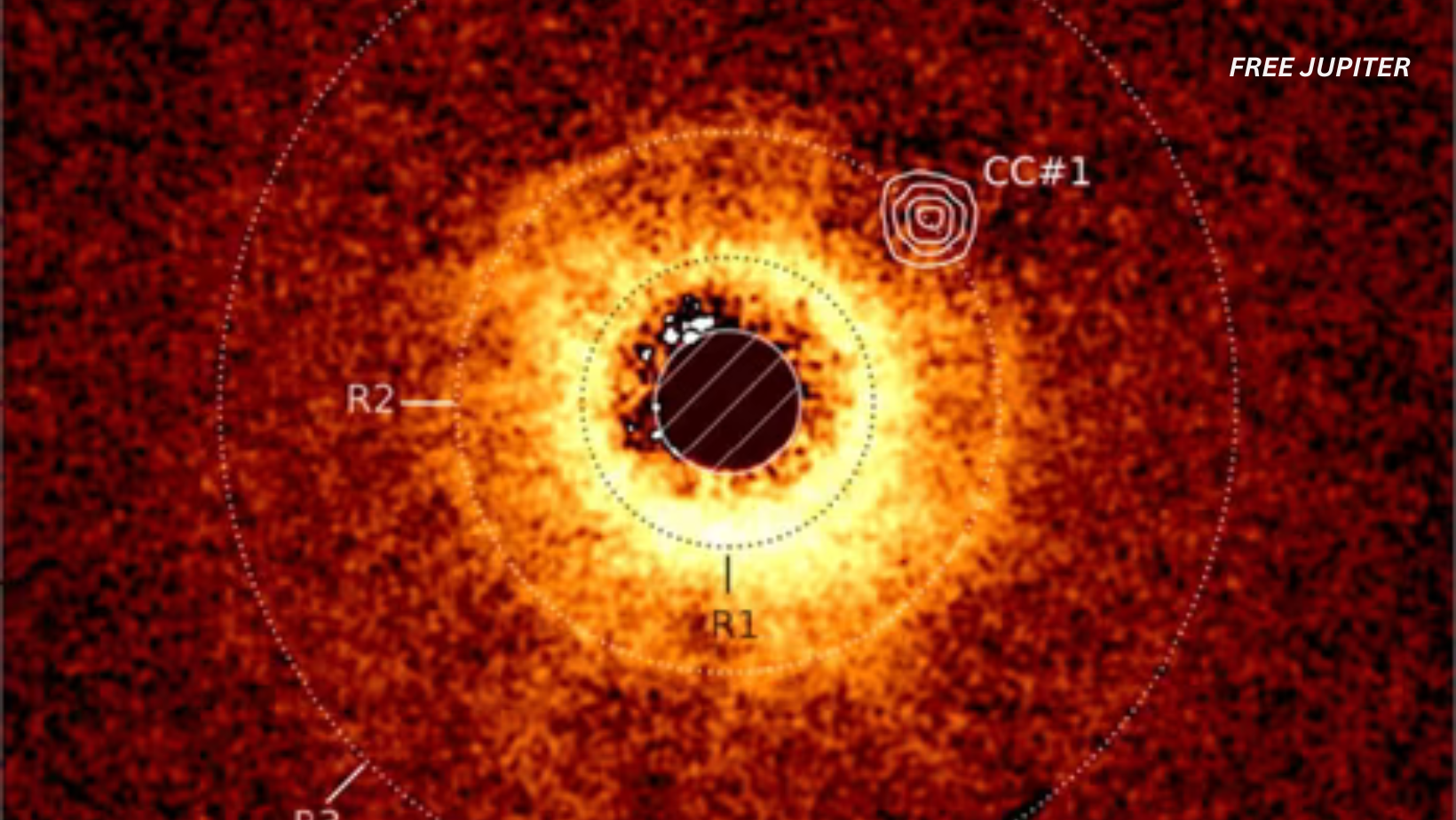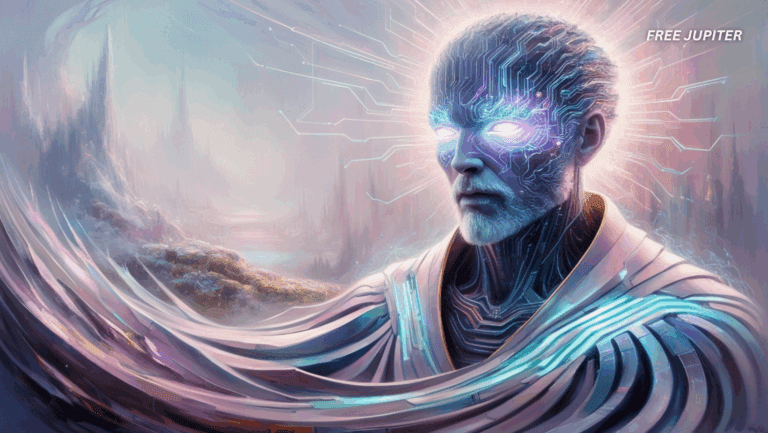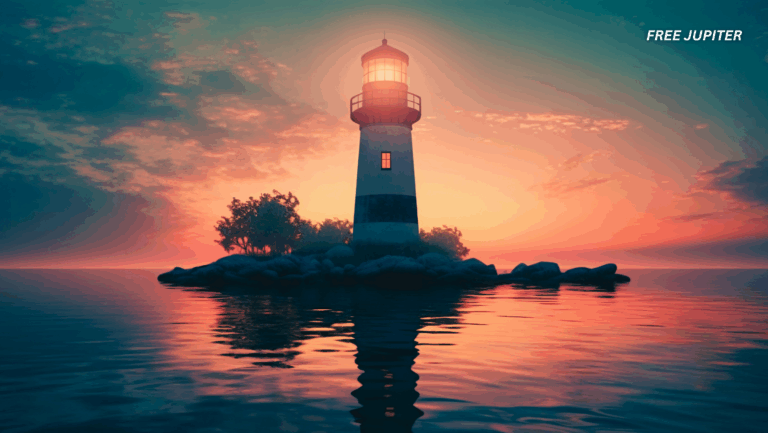Friendly Note: FreeJupiter.com shares general info for curious minds 🌟 Please fact-check all claims—and always check health matters with a professional 💙
Space just keeps showing off.
In a cosmic first for NASA’s most powerful eye in the sky, the James Webb Space Telescope (JWST) has managed to capture a direct image of a planet outside our solar system—a gas giant about the size of Saturn—as it swooshes through a glowing disc of space dust. Say hello to TWA 7b, a newly discovered exoplanet orbiting a very young star located about 110 light-years away from Earth.
Yes, that’s “light-years,” not “miles,” and definitely not “millions.” It’s close in cosmic terms, but still way beyond the reach of any human road trip.
The First—But Not The First
Let’s get this out of the way: TWA 7b isn’t the first exoplanet ever imaged, but it is the first discovered by the James Webb Telescope via direct imaging, and it also happens to be the lightest-mass exoplanet ever caught this way. Earlier telescopes like the Hubble and ground-based observatories have glimpsed distant planets before, but mostly ones that were heavier, brighter, and easier to spot.
So, while we’ve seen other cosmic neighbors before, this one is kind of like catching sight of a firefly in a stadium full of floodlights—and it’s a big win for team JWST.
What Makes This Discovery So Special?
Here’s what’s getting astronomers all starry-eyed:
- It’s a direct image, not inferred from a shadow or wobble.
- The planet is only as massive as Saturn, making it the lightest directly-imaged exoplanet to date.
- It lives in a star system that’s just 6 million years old, meaning we’re looking at a system in its galactic toddler years.
- It orbits its star 50 times farther away than Earth is from the Sun, taking centuries to complete a single year.
All of this gives scientists a rare opportunity to study not just a planet, but a planetary system that’s still forming. It’s like watching the opening scene of a cosmic movie—one that takes billions of years to play out.
A Glowing Disc, a Hidden World
The star, named TWA 7, is wrapped in a dusty disc—a swirl of gas, debris, and cosmic crumbs that can eventually come together to form planets. These dusty rings aren’t just pretty to look at; they’re full of drama. As new planets take shape and move through the disc, they carve out rings and gaps—a bit like boats leaving trails in a lake.
For years, astronomers have speculated that some of these visible rings were being shaped by hidden “shepherd” planets. TWA 7b proves they were right.
With the help of a special telescope attachment that blocks out the star’s bright glare (think: high-tech eclipse glasses), the team led by Dr. Anne-Marie Lagrange managed to spot the faint glow of the planet itself, hanging out inside one of these rings.
That’s not just impressive—it’s groundbreaking.
Read more: Astronomers Have Found A ‘Tatooine-Like’ Planet Orbiting Two Stars
JWST’s Growing Exoplanet Legacy
The James Webb Space Telescope (JWST) is still relatively new to the cosmic scene, but it’s already building a stellar reputation—literally. While the Saturn-sized TWA 7b is the first planet it’s directly imaged and discovered, it’s far from Webb’s first tango with alien worlds. In fact, since launching in late 2021, this infrared super-scope has been on a planet-hunting hot streak, helping scientists peek into the atmospheres of distant exoplanets and decode what they’re made of—without ever having to leave Earth.
How does it pull that off? Webb doesn’t need to snap visible photos of these planets to get a sense of them. Instead, it reads the starlight that filters through a planet’s atmosphere—sort of like shining a flashlight through a stained-glass window and analyzing the colors that pass through. Different gases absorb different wavelengths of light, and that’s how scientists can tell what a planet’s air is made of.
First Big Splash: WASP-39b
One of JWST’s earliest exoplanet wins came in 2022, when it studied a gassy, bloated world called WASP-39b—a “hot Saturn” located about 700 light-years away. This planet is nothing like Earth: it’s much bigger, way hotter, and orbits extremely close to its star. But it turned out to be the perfect testing ground for Webb’s tools.
What Webb found was stunning: the first clear detection of carbon dioxide (CO₂) in an exoplanet’s atmosphere. This was a huge deal. Not just because it confirmed CO₂ could be measured so far away, but because it opened the door to eventually finding gases like oxygen or methane—potential markers of habitability.
In short: Webb proved it could not only find alien worlds, but start to sniff their air.
The Search for Life: K2-18b and the “Alien Ocean”
Fast-forward to 2023, and JWST was making headlines again. This time, it turned its gaze to a much more Earth-like planet: K2-18b, a “sub-Neptune” that sits comfortably in its star’s habitable zone—that’s the not-too-hot, not-too-cold region where liquid water could exist.
What made this even more exciting? Scientists detected possible hints of dimethyl sulfide (DMS)—a chemical that, on Earth, is almost exclusively produced by living organisms, mainly plankton. Now, to be clear, this doesn’t mean aliens are waving from the waves. The signal was faint, and more observations are needed. But still—finding a potential biosignature on a planet 120 light-years away? That’s not something you see every day.
K2-18b also appears to have a watery atmosphere, suggesting it could be surrounded by an ocean-covered surface, possibly beneath a thick hydrogen-rich shell. This sparked conversations about a whole new class of worlds: Hycean planets—a blend of hydrogen and ocean. They’re not quite Earth 2.0, but they might just be good enough to support life in some form.
Read more: Investigator Says Mysterious Mars Structures ‘Prove There Was Life’ On The Red Planet
Why JWST’s Planetary Work Matters
Each of these discoveries—whether it’s CO₂ in a gassy giant or DMS in a watery world—adds a puzzle piece to one of humanity’s oldest questions: Are we alone?
JWST is helping reframe how we look for answers. It’s not just spotting exoplanets anymore. It’s characterizing them—measuring their temperatures, compositions, cloud patterns, and possibly even their seasons. We’re not just seeing that distant planets exist; we’re starting to understand what they’re like.
This kind of detail used to be the stuff of science fiction. Now, it’s just Webb doing its job.
From Super-Jupiters to Mini-Earths
While most of the planets studied so far are massive and gaseous (because they’re easier to detect), JWST is paving the way to one day study smaller, Earth-sized planets. With every new technical achievement—like the direct imaging of TWA 7b—it’s getting closer to spotting rocky worlds in Earth-like orbits around stars like our Sun.
Imagine it: a telescope a million miles from Earth, quietly observing tiny worlds with oceans, clouds, and maybe even alien weather.
A Legacy in the Making
TWA 7b may be a record-breaking first, but it’s also part of a much bigger legacy JWST is crafting—a legacy that could eventually lead us to the first confirmed habitable world, or maybe even the first hint of extraterrestrial life.
With every image, every atmospheric reading, and every dusty ring it uncovers, the James Webb Space Telescope is helping turn the abstract idea of “other worlds” into real, observable places.
And that’s not just science—that’s history in the making.
Read more: Massive Martian Ice Deposit Could Flood The Entire Planet Under 9 Feet Of Water
So… What Happens Next?
The discovery of TWA 7b is just the beginning. Scientists plan to monitor the planet and its surrounding system in the years ahead. Observations like this can help answer big questions:
- How do gas giants form in dusty discs?
- Do baby planets move closer to their stars as they grow older?
- Could we one day see rocky, Earth-like planets forming in similar systems?
With JWST just a few years into its mission, the odds are good that more baby planets will show up in our cosmic crib notes.
Final Thoughts: A Snapshot of Cosmic Youth
TWA 7b isn’t just a distant gas ball—it’s a snapshot of a planetary system in its awkward teenage years, caught mid-transformation by the sharpest camera ever launched into space. And the fact that we can see it at all, from a hundred light-years away, is nothing short of mind-blowing.
So next time you glance up at the night sky, remember: somewhere out there, a baby Saturn is carving paths through stardust—while a $10 billion telescope quietly captures the magic from afar.










